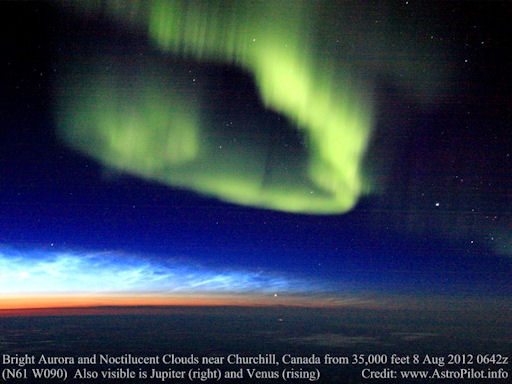Listen to radar echoes from satellites and meteors, live on listener-supported Space Weather Radio. | | |
PLANETS ALIGN THIS WEEKEND: The Moon, Venus, and Jupiter are lining up in the eastern sky this weekend--right in the middle of the Perseid meteor shower. It's a must-see event. A new ScienceCast video from NASA previews the display.
PERSEID METEOR SHOWER: The annual Perseid meteor shower is underway. International observers are reporting 15+ meteors per hour in pre-dawn skies as Earth enters a broad stream of debris from parent comet Swift-Tuttle. The shower has been building since late July. Over the past two weeks, NASA's All-Sky Meteor Network has recorded more than 57 Perseid fireballs. Their orbits are shown here, with Earth's position marked in red:

The show is about to get much better. Earth will pass through the heart of the debris stream on the nights of August 11th through 13th, boosting meteor rates beyond 100 per hour. Forecasters say the best time to look is probably during the dark hours before sunrise on Sunday, August 12th.
Got clouds? Tune into SpaceWeather Radio for live echoes from Perseid meteors flying over the US Space Surveillance Radar in Texas.
Realtime Meteor Photo Gallery
AURORA BOREALIS: According to NOAA, a slow-moving coronal mass ejection (CME) delivered a glancing blow to Earth's magnetic field on August 8th. Solar wind signatures barely registered the impact; nevertheless, the Arctic Circle lit up with auroras. Pilot Brian Whittaker photographed the display through the window of an aircraft flying 35,000 feet above Churchill, Canada:

"It was terrific to see a sky full of green Northern Lights and electric-blue noctilucent clouds side by side over the Hudson Bay," says Whittaker. "Eventually, as the sun rose, the auroras faded. For a while, the noctilucent clouds filled the entire sky in their place before they too faded with day break."
For the record, the airplane was 11 km high. The noctilucent clouds were 83 km high. The auroras were ~150 - 200 km high.
NOAA forecasters estimate a 15% to 30% chance of more geomagnetic activity today as effects from the CME wane. Arctic sky watchers should remain alert for auroras. Aurora alerts: text, phone.
Realtime Aurora Photo Gallery
Realtime Space Weather Photo Gallery
Realtime Noctilucent Cloud Photo Gallery
[previous years: 2003, 2004, 2005, 2006, 2007, 2008, 2009, 2011]
Potentially Hazardous Asteroids (
PHAs) are space rocks larger than approximately 100m that can come closer to Earth than 0.05 AU. None of the known PHAs is on a collision course with our planet, although astronomers are finding
new ones all the time.
On August 9, 2012 there were potentially hazardous asteroids.
Notes: LD means "Lunar Distance." 1 LD = 384,401 km, the distance between Earth and the Moon. 1 LD also equals 0.00256 AU. MAG is the visual magnitude of the asteroid on the date of closest approach. | | The official U.S. government space weather bureau |
| | The first place to look for information about sundogs, pillars, rainbows and related phenomena. |
| | Researchers call it a "Hubble for the sun." SDO is the most advanced solar observatory ever. |
| | 3D views of the sun from NASA's Solar and Terrestrial Relations Observatory |
| | Realtime and archival images of the Sun from SOHO. |
| | from the NOAA Space Environment Center |
| | the underlying science of space weather |

